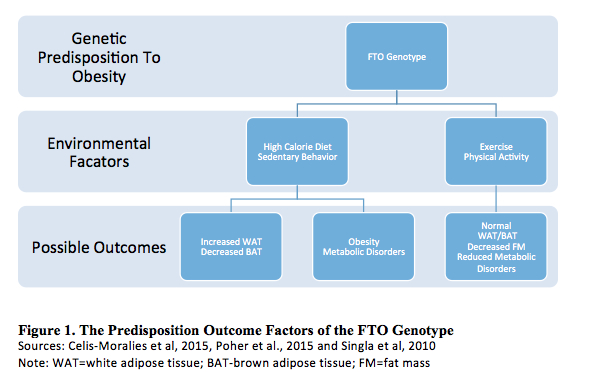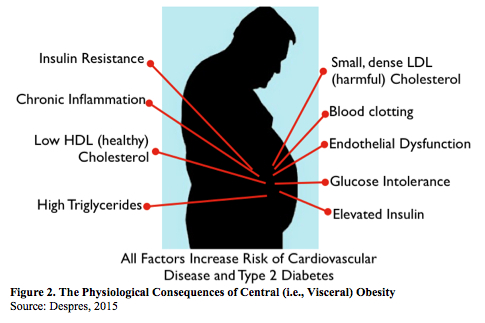| Fresh Insights on Fat Robert Christner, M.S. and Len Kravitz, Ph.D. Introduction The long-established role of adipose tissue as the principle energy storage tissue in the body is well-substantiated and understood. However, it is now known that fat tissue is a major endocrine (hormone secreting) organ, producing cell signaling proteins called adipokines, which play an important role in metabolism, feeding behaviors, glucose regulation and insulin control (Singla et al., 2010; Al-Suhaimi and Shehzad, 2013). Other new insightful understandings regarding the FTO gene, being fat and fit, extreme exercise and dieting programs, and weight regain after intentional weight loss have recently come to the forefront, and are reexamined in this column. New Insights on Adipokines: Leptin, Adiponectin, and Visfatin Subcutaneous (under the skin) or visceral (surrounding body organs) white fat tissue is responsible for the secretion of an array of messenger molecules, termed adipokines (Kwon & Pessin, 2013). Adipokines are a group of biologically active proteins closely involved with food intake, fat storage, metabolic disorders, and pro- and anti-inflammatory processes (Al-Suhaimi et al. 2013). The adipokines communicate with other organs including the liver, brain, muscle, immune system and other fat tissues (Kwon, & Pessin, J.E., 2013). The three adipokines of interest in this column are leptin, adioponectin and visfatin. Leptin Leptin whose name is derived from the Greek leptos, which means thin, was the first identified adipokine in 1994 by Dr. Jeffrey Freidman (AL-Shumai and Shehzad, 2013). It has several roles in the body, such as with growth, immune system regulation, and insulin sensitivity control (AL-Suhaimi and Shehzad, 2013; Singla et al., 2010). Leptin is one of a specific group of proteins, secreted by adipose tissue, that help control body weight by regulating a person's metabolic behavior. This means it is directly involved in triggering a person to decide to have a snack. Thus, leptin serves an essential role in regulating energy expenditure and helping to control appetite. Leptin levels in the blood plasma have been found to be elevated in obese individuals (Paracchini et al., 2005). The higher plasma levels are often accompanied with reduced leptin action in the brain. Whether this dysfunction is a central cause leading to obesity is currently debatable, and the answer remains to be determined (Singla et al, 2010). Adiponectin Adiponectin, which is secreted from adipose tissue, helps to regulate metabolic homeostasis (or balance). It is involved in the beneficial enhancement of insulin sensitivity, anti-inflammatory effects and decreased atherosclerosis (AL-Suhaimi and Shehzad, 2013). High levels of adiponectin are found in lean individuals (Singla et al., 2010). Adiponectin has been shown to positively increase liver insulin actions and glucose uptake in skeletal muscle and the liver (Singla et al., 2010). Singla and colleagues note that adiponectin production and concentration in the blood decreases with obesity. However, adiponectin also has several protective effects of the blood vessels. Thus, the low levels of adiponectin observed in obesity may help explain the increased cardiovascular risk association with obesity (Singla et al., 2010). Visfatin Visfatin is an adipokine protein hormone that is found at increased levels with abdominal obesity and type 2 diabetes (Beltowski, 2006). Visfatin, produce by visceral fat, stimulates the maturation of pre-adipocytes to mature fat cells, induces triglyceride (stored form of fat in human body) accumulation and accelerates triglyceride synthesis from glucose. Beltowski notes that the increased levels of visfatin observed with obesity may actually be a compensatory response aimed at maintaining blood glucose. This suggests that visfatin exerts a beneficial hypoglycemic (glucose lowering) effect by stimulating glucose utilization in peripheral tissues (Beltowski). Beltowski highlights that although visfatin appears to be protecting against obesity-related pathologies, more research is needed to determine if it has a potential health use in the treatment of obesity. New Insights on the FTO Gene and Physical Activity In 2007, a large study of over 38,000 Europeans identified a fat and obesity-associated gene, the FTO gene, that predisposes children and adults to diabetes and obesity (Frayling et al., 2007). Yet, until now, there has been little research on the effect of physical activity and the FTO gene (See Figure 1). In the Food4me study with 743 women and 537 men (ave. age = 40 yrs), Celis-Morales et al. (2016) collected physical activity data with accelerometers for over a 2-week period with all study participants. The study results showed that people achieving between 10 and 90 min of vigorous physical per week alleviated the effect of the FTO genotype on obesity measures. With moderate intensity physical activity, 150-300 min per week are needed to lessen the association between the FTP genotype and obesity. The implications of this new research are quite profound for personal trainers. As highlighted by the researchers, this study emphasizes that physical activity is a particularly effective way of managing body weight in individuals with a genetic predisposition towards obesity, and thus contradicts the deterministic view that genetic influences on obesity are un-modifiable! |
||||||||
 |
||||||||
| New Insights on Fat but Fit The paradigm of being fat but fit has stimulated new interest in medicine and is an important consideration for exercise professionals. Despres (2015) states that it is imperative to point out that most persons who are fat but fit are in the overweight/moderate obesity range. They are not massively obese. Despres continues that fat but fit individuals have less visceral adipose tissue (See Figure 2) for a given BMI than fat but unfit persons. Additionally, Despres summaries that several lifestyle modification studies that have incorporated an endurance exercise program have shown that it can induce a selective loss of abdominal visceral adipose tissue and fat around the heart, with no change in body weight. Finally Despres emphasizes that changing from a sedentary behavior to a physically active lifestyle has been shown to turn on the expression of numerous genes for proteins involved in structural, physiological and metabolic adaptations. These changes provide cardioprotection, irrespective of weight loss. This is another chief take-home message for personal trainers to emphasize to clients that striving for health may be much more health beneficial, as opposed to a struggling lifestyle for an unattainable 'model' figure. New Insights on Previous Research Column Entitled the “Dieting Does Makes You Fat! How? In our last column, we reported on a study with 14 Biggest Loser participants (6 men and 8 women) followed for six years after the contest, who have regained a substantial amount of the weight they lost on the 30-week exercise/nutrition intervention. Surprising, at the 6-year follow-up the participants resting metabolic rates were dramatically suppressed. These findings garnered some very hot topic discussions at the recent IDEA World Convention in Los Angeles. Many fitness professionals and exercise scientists note that the research highlights something very important. It clearly shows how harmful it can be to attempt to lose massive amounts of weight unnaturally, with extreme exercise and dieting. The take-home message is clear; gradual, reasonable weight loss leads to developing new, healthy behaviors, that prevent weight regain. New Insights on Abnormal Hormone Levels After Intentional Weight Loss Stohacker and colleagues (2014) completed a systematic review of studies that assessed leptin, ghrelin (a very potent appetite-stimulating hormone) and insulin sensitivity during weight loss, and tested the relationship between such changes and weight regain. The researchers noted that in reviewing the clinical weight loss trials, neither decreases in leptin or insulin sensitivity nor increases in ghrelin reliably predicted subsequent weight regain. The researchers propose that future investigations need to determine if there is a 'conglomerate effect' of several hormones (including leptin, ghrelin, insulin, peptide YY, cholecystokinin, amylin and glucagon-like peptide-1) on weight regain. For now, Stohacker et al. suggest we should focus on changing obesogenic environments (environment that promotes gaining weight) now observed in most nations. These environments are evidenced by decreased opportunities for activity, with fewer walkways or cycle paths for recreation. This is all coupled with fast food temptations everywhere, sugar-sweetened beverages, pastries, desserts and large portion meal sizes at most eateries. Summary Thoughts With so much new research and new understandings on fat, one message still seems to prevail, that truly leads the direction for fitness professionals. 'Changing from a sedentary behavior to a physically active lifestyle has enormous health benefits.' Start and Keep Moving! |
||||||||
 |
||||||||
| References: Al-Suhaimi, E.A., & Shehzad, A. (2013). Leptin, resistin and visfatin: the missing link between endocrine metabolic disorders and immunity. European Journal of Medical Research, 18:12. doi:10.1186/2047-783X-18-12. Be_towski, J. (2006). Apelin and visfatin: unique "beneficial" adipokines upregulated in obesity? Medical Science Monitor, 12(6), RA112-119. Celis-Morales, C., Marsaux, C.F.M., Livingstone, K.M. et al. (2016). Physical activity attenuates the effect of the FTO genotype on obesity traits in European adults: The Food4Me study. Obesity, 24(4), 962-969. Frayling, T.M., Timpson, N.J., & Weedon, M.N. et al. (2007). A common variant in the FTO gene is associated with body mass index and predisposes to childhood and adult obesity. Science, 316:889-894. Kwon, H. & Pessin, J.E. (2013). Adipokines Mediate Inflammation and Insulin Resistance, Frontiers in Endocrinology, 4: 71, doi: 10.3389/fendo.2013.00071 Paracchini, V., Pedotti, P. & Taioli, E. (2005). Genetics of Leptin and Obesity: A HuGE Review, American Journal of Epidemiology, 162(2), 101-114. Poher, A-L., Altirriba, J., Veyrat-Durebex, C., & Rohner-Jeanrenaud, F. (2015). Brown adipose tissue activity as a target for the treatment of obesity/insulin resistance. Frontiers in Physiology, 6(4). doi:10.3389/fphys.2015.00004 Singla, P., Bardoloi, A., & Parkash, A.A. (2010). Metabolic effects of obesity: A review. World Journal Diabetes, 1(3), 76-88. Stohacker, K., McCaffery, J.M., MacLean, P.S. et al. (2014). Adaptations of leptin, ghrelin or insulin during weight loss as predictors of weight regain: a review of current literature. International Journal of Obesity, 38, 388-396. |
||||||||
|
|
||||||||
|